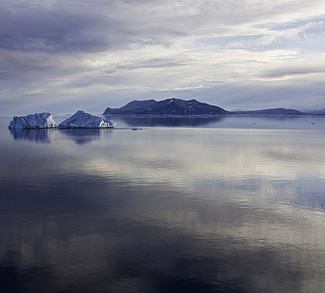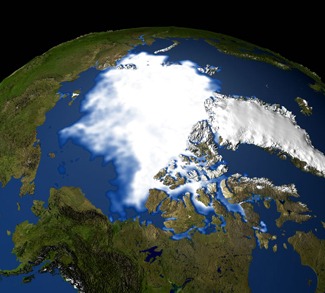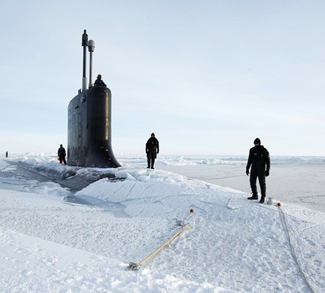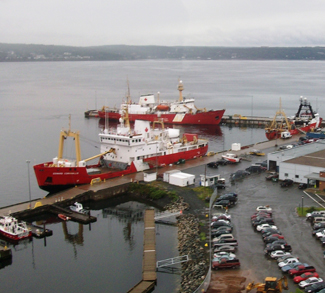As Prime Minister Stephen Harper made his annual northern trek this month, people interested in Canadian affairs could not have missed the fact that climate change has affected a precipitous transformation of the Arctic’s physical and political landscapes. The impregnable cold of Canada’s northern geography has historically provided security and identity to the country; however, the expeditious rate of physical change necessitates a shift in perspective. Now regarded as a viable area for commercial development and shipping, as well as a valuable revenue stream for future governments, the Arctic is no longer a source of security, but rather a region that is in need of securing. This paradigm shift should have precipitated a similar shift in the strategy and rhetoric of Canadian politicians asserting Arctic claims, but it has not.
Current Canadian rhetoric, with its evocation of sovereignty and accompanying legalese discussion, is subjecting the Northwest Passage claim to an illusory measure of legitimization. As the possibility for a process of propriety adjudication is at best uncertain, and the outcome of such a process wholly unknowable, it would be prudent to emphasize an alternative rationale for support. It is thus the pragmatism of security, rather than the legality of sovereignty, that should be made paramount in Canadian Arctic assertions.
The most prevalent issue facing Canada in the Arctic is its contested dominion over the constitutive straits of the Northwest Passage (NWP). Canada’s current position, both politically and in terms of physical assets, demands some level of international support and respect for its claim to be credible. To this end, the support of the United States (US)- as Canada’s partner in NWP maritime surveillance through NORAD- must be viewed as critical for success. Current Canadian rhetoric, however, has made it increasingly difficult for the US to acquiesce.
US opposition to Canada’s NWP claim is predicated on the US Navy’s concern regarding the possibility for analogous assertions of propriety on behalf of less friendly states over waterways currently deemed “international straits.” The designation of a waterway as an international strait severely impedes the adjacent country’s right to regulate and/or deny transit to vessels of all flags, including commercial and military. The designation is viewed as a necessity to ensure that no one state has the capacity to severely undermine naval operational capacity or international commerce. But in the case of the NWP the legality of the international strait designation remains ambiguous, and its application does not adequately serve the security interest of Canada or the US.
National security interests often provide impetus for the abandonment of foreign policy positions, and above other arguments, Canada must give this issue precedence in Arctic negotiations. For instance, a major concern is the possibility that should Canada or any other country not possess the ability to board, detain, or otherwise exercise authority over transiting vessels in the NWP, unwanted persons or illicit material may enter North America. The propensity for such an occurrence is exacerbated by three factors: first, if current US policy prevails and the NWP is respected as an “international strait”, access to the NWP would be akin to a right rather than a privilege, only to be inhibited in extremely limited circumstances; second, there is a vast discrepancy between the surveillance and reactionary capacity that Canada and the US possess, and the extraordinary expanse that they are charged with surveying; and finally, there is a significant number of rudimentary airstrips in the Canadian north with limited or no security and immigration personnel which could be utilized to gain access to the North America’s more densely populated areas.
As University of British Columbia Arctic expert Michael Byers, and former US Ambassador to Canada Paul Cellucci have both articulated, a solution to the issue of securing the north is partially achieved in US support for Canadian control of the NWP. Practically speaking, this would enhance Canada’s capacity to actively patrol the entrances to the NWP with the authority to deny access. This negates the issue of surveying the entire expanse of the NWP with similar dutifulness by creating a “choke-point” at which scarce resources can be directed. More importantly, this provides a significant barrier to entry to persons or material that may pose a threat to continental security.
US support would further allow for the coordination of the two states’ respective Arctic strategies. For instance, should Canadian claims be recognized, there is a possibility that Canada could bilaterally endow US vessels with the ability to detain ships in internal Canadian waters with the oversight of the existing bilateral command center at NORAD. Aligning their respective procurement policies would also assist in securing the countries’ shared northern coastline. As an example, so-called “heavy” icebreakers, of which each country currently possesses only one in operation (although the US Coast Guard possesses three, the USCGS Healy is the only one in operation, with the Polar Sea “inactive”, and the Polar Star in the process of a retro-fit), are in short supply. A coordinated demarcation of operational responsibility for respective icebreaker fleets would be a responsible strategy in the short-term; while a coordinated procurement policy for additional assets destined for the Arctic would serve long-term interests.
The support of the US and other countries is crucial for Canada’s claim to the NWP; however, there would assuredly be other beneficiaries should Canada’s claim be recognized. Industry increasingly views the Arctic as a viable area for commercial investment, with vast economic potential. A 2009 estimate of undiscovered energy resources suggests that ninety billion barrels of oil and forty-six trillion cubic-meters of natural gas are present in the Arctic. The savings in fuel, time, and fees available through transit of the NWP are incredibly enticing for cargo vessels of all kinds, particularly supertankers too large for the Panama Canal. There is also a plethora of mineral deposits, large stocks of fish, and a growing tourist industry drawing business interests northward.
Responsible industry may view the Arctic as a mid-to-long-term investment. However, less reputable actors may be enticed by the financial savings (reduced time, fuel, and fees) offered by shipping via the NWP. This may be the most immediate concern for all Arctic stakeholders, and is a risk that can be best mitigated through Canadian control of the waterway. The current situation is incredibly perilous, as Captain Melissa Bert of the US Coast Guard points out, “despite the dangerous conditions, the Arctic has no mandatory requirements for those operating in or passing through the region. There are no designated shipping lanes, requirements for ice-strengthened hulls to withstand the extreme environment, ice navigation training for ships’ masters, or even production and carriage of updated navigation and ice charts.”
What is perhaps most perplexing is that in the event of a crisis, the necessary responding vessels and aircraft are often days away. Should an environmental accident occur, which may be viewed as likely under the current (lack of) regime, the dearth of responsive assets currently allocated to the Arctic could exacerbate a relatively minor incident and cause enormous devastation—environmentally or otherwise. It could take years for public support of resource development and shipping in the Arctic to recover. Subsequent public protest could impede responsible economic development, causing financial harm to potential investors and governments. Furthermore, there may be dire consequences for the livelihood of native populations in the north, who have made the shores of the NWP their home for millennia; and who are to share in the financial gain realized through the responsible development of northern resources.
Full regulatory control of the NWP would allow Canada to enact safety measures and enforce their compliance to the fullest extent prior to entry of the waterway. This would serve to protect the environmental integrity of the delicate Arctic environment, the security of North Americans, the interests of responsible industry, and the livelihood of northern populations. While some may view Canadian regulatory mechanisms as less than ideal, they assuredly would be an improvement upon the current status that allows for near unimpeded access to the treacherous seas of the NWP.
As historic partners and Arctic stakeholders, Canada and the US have much to gain through the strategic coordination of their respective environmental, commercial, procurement, and security policy in the far north. However, with regard to the immediate concern of increasing numbers of transiting vessels in the NWP, the two states’ respective positions are a direct impediment to responsible Arctic stewardship. Pragmatic security solutions, rather than the illusory definitions of international legal regimes, provide the most salient rationale for vital US support, and the rhetoric of Canadian politicians must begin to reflect this.




